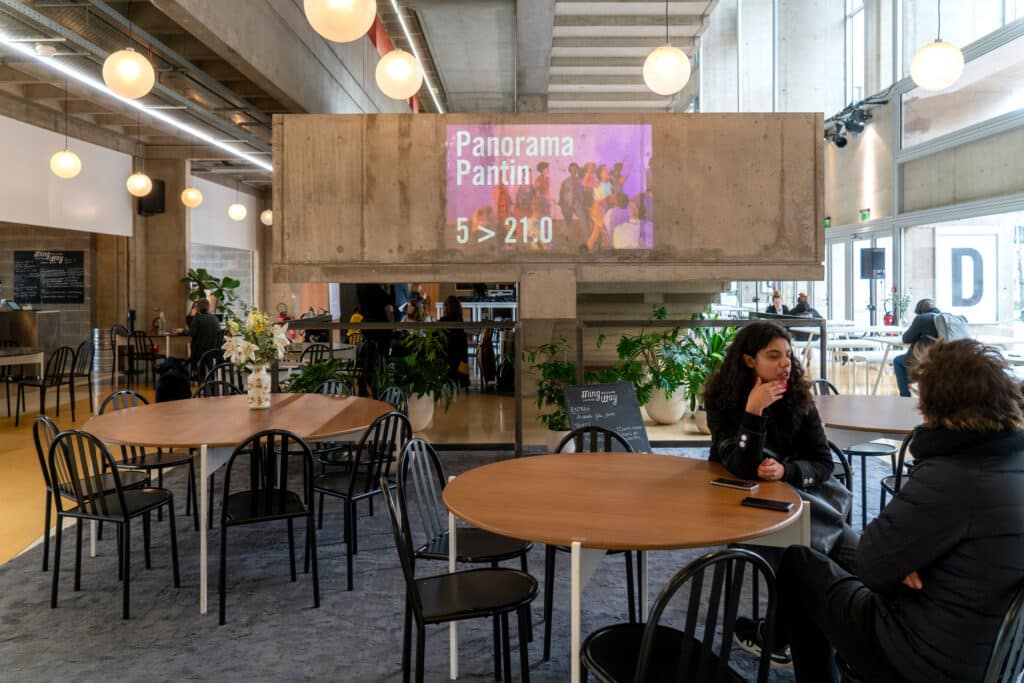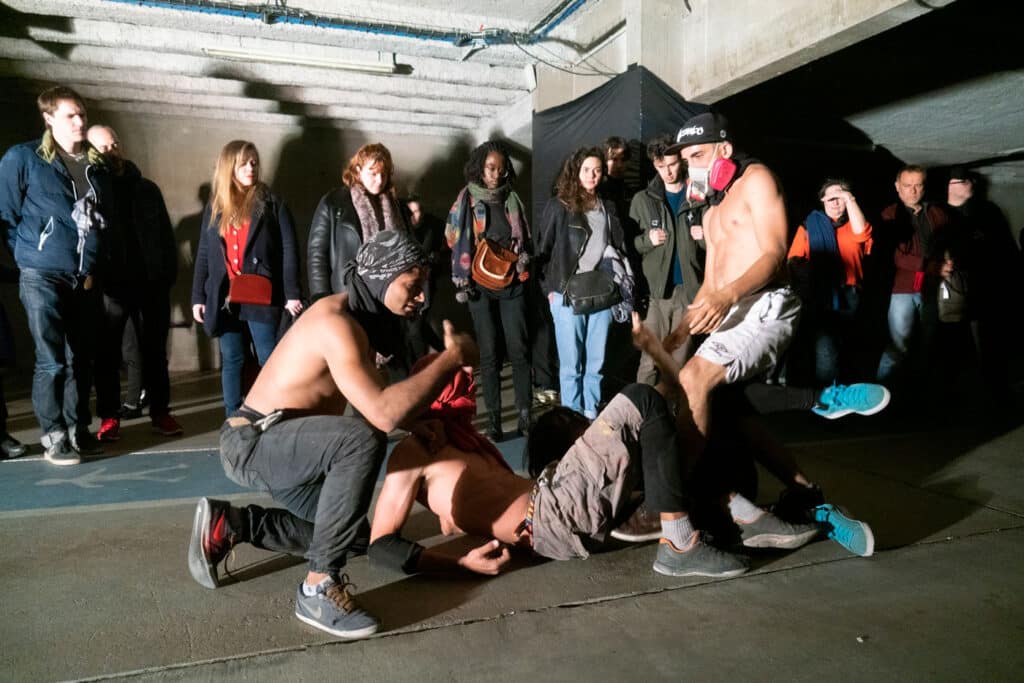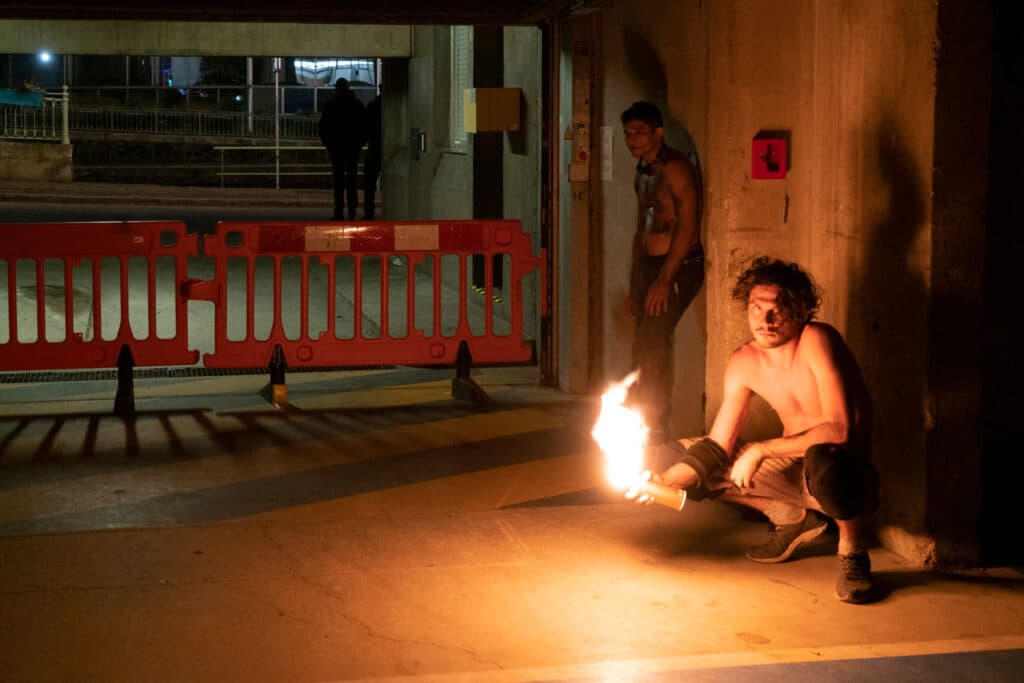The brazilian event took place from March 5 to 14 at the Centre National de la Danse (CN D), featured the shows Quando Quebra Queima, Treta, Intervalo, Samba do Crioulo Doido, Gente de Lá and Proyecto Tango, in addition to parties and tables of debate.
A vast and fertile territory of resistance and critical reflection in motion, this was another edition of the Festival Panorama, which this year, settled in Pantin, at the Centre National de la Danse (CN D) – an initiative of the Ministry of Culture and French Communication, created in 1998 and which in a single institution centralizes a wide range of professional activities for the benefit of dance. The program designed three weeks with concerts, performances, round tables, meetings and parties. However, with the pandemic that started in Europe in the middle of March, it was necessary to reschedule some presentations and cancel other activities. Thus, we had six shows: Quando Quebra Queima, Treta, Intervalo, O Samba do Crioulo Doido, Gente de Lá and Proyecto Tango.
Panorama’s program brought young, mature, black, white, straight, gay, cis, trans bodies to France, dialoguing with the issues that have gone through the festival in recent years. “We are at the center of resistance from these bodies, which are marginalized in the current government’s discourse,” says director Nayse Lopez. The curatorship at CN D, in Pantin, raised three major questions: the “future”, giving young people a voice to express their anger and anguish for what happens in Brazil and in the world; on the second weekend, the axis of the past, where the idea is to check at what point in history bodies like black or gay were prevented from being protagonists. Highlight for the Coletiva Ocupação, which took a new scene during the show Quando Quebra Queima, which simulates a popular uprising, created especially for the Panorama 2020 Festival. “We brought a fight from the streets of Paris, which has existed for a long time, it became stronger in the yellow vest movement, and also in strikes, which is “Tout le monde déteste la police (everyone hates the police). We created a song, scream-song, produced by Djs Shaolin and Akin, from Coletiva Ocupação,” says director Martha Kiss Perrone.
The show transcended the CN D space and gained the streets of Pantin. “Participating in Panorama brought a realization of our struggle. Leaving the theater and going to the street works organically, as we are already displacing the public, preparing for this moment of the uprising. The show had its dramaturgy created collectively, from the experiences and memories of the student-performers, who wrote scenes from the records of their diaries, songs, choreographies and photographs ”, says Lilith Cristina, 20 years old, performance and actress invited by festival. The group emphasized on the scene the struggle of the secondary movement, which appears demanding quality public education in 2015 in São Paulo, and ends up becoming a more comprehensive struggle, which focuses on autonomy for young black and LGBTQI peripherals, and for these protagonists may be responsible for their own destinies and may have subjectivities protected and not determined by the system.
In this edition, we also address the Latin American body as a whole, representing this spectrum, Federica Folco’s play, Proyecto Tango, from Uruguay, a show that talks about the origin of tango as a place of struggle in the country’s ports, is a struggle that turns into dance, with a very important political charge to think about what was the construction of the Latin American art ideology. Just like Wellington Gadelha’s play, Gente de Lá, who is from the periphery of the Brazilian Northeast. He who poses as a peripheral black man in a colonial country had problems executing the show. Even so, with some serious mishaps and equipment that did not arrive, the artist bravely presented himself, reaffirming the power of urgent work in the current scenario. “The pre-pandemic climate was very strong there and it directly affected the presence of the public and the sharing of work. I hope there will be another opportunity to share the show. And of the few people who came to see the work, I realized that the connection was very fragile. My work is eye to eye, presence, smell, sweat. And due to all the proximity measures, some things did not happen. It was a challenge to share under the given circumstances, but it happened ”, points out Wellington, who is trying to recover damages suffered in his work material during the transfer made by UPS Tracking, the company responsible for the cargo. “Despite the damage to the material I am still trying to recover, it was very important to see up close the modes of production and execution of Festival Panorama happening at CN D. I was able to understand the pillars that involve the articulation of a national and international festival”, he says. Gadelha.
Beyond the spectacles there was a party that had over a thousand people, and was led by Dj Omulu. There was also an emblematic debate table focused on youth “Do not trust anyone over thirty”, mediated by the director of the festival Nayse López. “These were days of uncertainty that we turned into fuel to move these bodies that have moved to another continent. Festival Panorama pursues the commitment to enable a platform for transmitting artistic productions that are often excluded from institutional networks. Faithful to this positioning, the edition held in Pantin brought together young companies in the process of professionalization, some more accustomed to informal spaces than to official scenes ”, emphasizes Nayse.
In total, the festival had an audience of thousands of paying people, and more than 50 professionals, including artists and technical staff. With three proposed weeks and only two weeks of activity, the curatorship assumed a time axis (future, past, present). From March 5 to 14, the program addressed issues through the prisms of education and technology, decolonial thinking, censorship and information in today’s democracies. This political reflection continued during the round table and several meetings, especially dedicated to issues of minority rights (LGBTQI or indigenous peoples). Tickets sold out on the first weekend, the public would have doubled had it not been for the cruel reality of a pandemic that began in the third week of the festival, postponing the presentation of the shows Looping: Paris Overdub (Felipe de Assis, Leonardo França and Rita Aquino ), and Domínio Público (Elisabete Finger, Maikon K, Renata Carvalho and Wagner Schwartz).
In an interview with the newspaper O Globo, in March 2020, director Aymar Crosnier, responsible for CND’s artistic programming, described the dubious feeling of receiving the Panorama Festival in Pantin, and commented that the invitation to this political artistic asylum was made in time of Jair Bolsonaro’s victory to the Presidency. “The government’s program in relation to civil society and artists has unfortunately been implemented. Panorama was forced to cancel the festival for the first time since 1992. It’s an “asylum land” invitation to the event, which, I hope, can happen again in Brazil. It was mainly an act of solidarity. In my career as a programmer, it’s one of the most political projects I’ve ever had. It was a privilege to host the festival here. A sad privilege, unfortunately, ”says Crosnier.
The fact is that by becoming the host of Festival Panorama, beyond a transcontinental walls, CN D has consolidated ties with Brazilian choreographers in recent years, from Lia Rodrigues, Wagner Schwartz, Calixto Neto and Marcelo Evelin, guests of previous Camping editions, to Volmir Cordeiro, associate artist between 2017 and 2019. But he also shows above all the intention to create the new, to affirm international solidarity and to work towards the definition of art as a complete act of resistance. The future of the Panorama festival, however, is still uncertain, as Nayse López says. “We are not sure here in Brazil at the moment or what will happen next month”, he points out. “Faced with a situation of great financial insecurity, in 2019 we decided not to announce an edition that might not be held due to lack of resources. In parallel to this, as it is a very old festival, we came to the conclusion that it was time to stop and rethink the format ”, he says. “What kind of project meets the needs of contemporary performance artists and the public at the moment?”, emphasizes the curator.
Panorama was widely publicized in France, with extensive coverage by Brazilian and European correspondent journalists. Some of the artists participated in live interviews at RIF radio studios, as well as on television channels. Two words were, and continue to be very important to sum up the last edition of the festival that took place in France: Resistance and resilience. Believing that what we do has importance and resonance and needs to be done. And also solidarity, because the decision of Mathilde Monnier (former director of CN D), when reiterated [by the new French management] was not only an act of solidarity with an artistic community that is in some way at risk of survival due to the absence public policies, but also by the CN D’s understanding of its role. It is not simply a theater, it is a national reference center that looks at what is happening in dance, in France and in the world ”, says the director of Panorama.





















